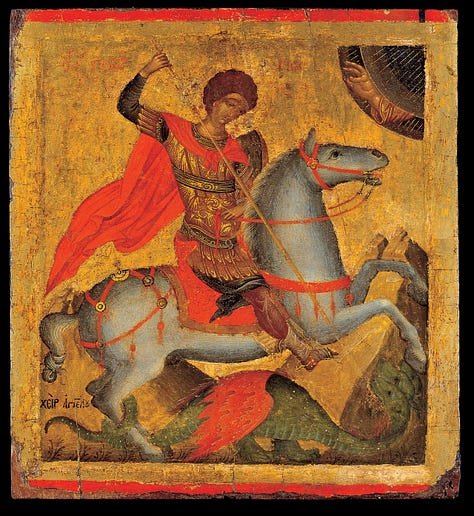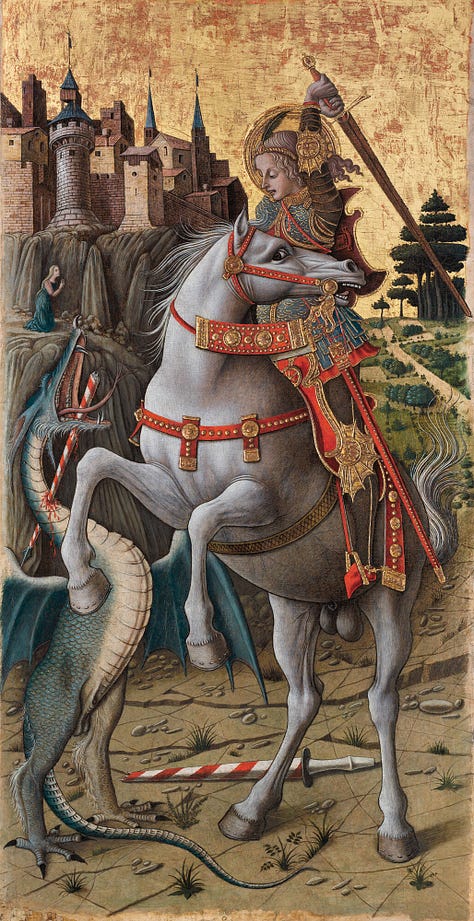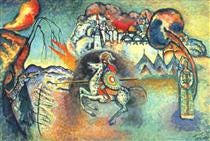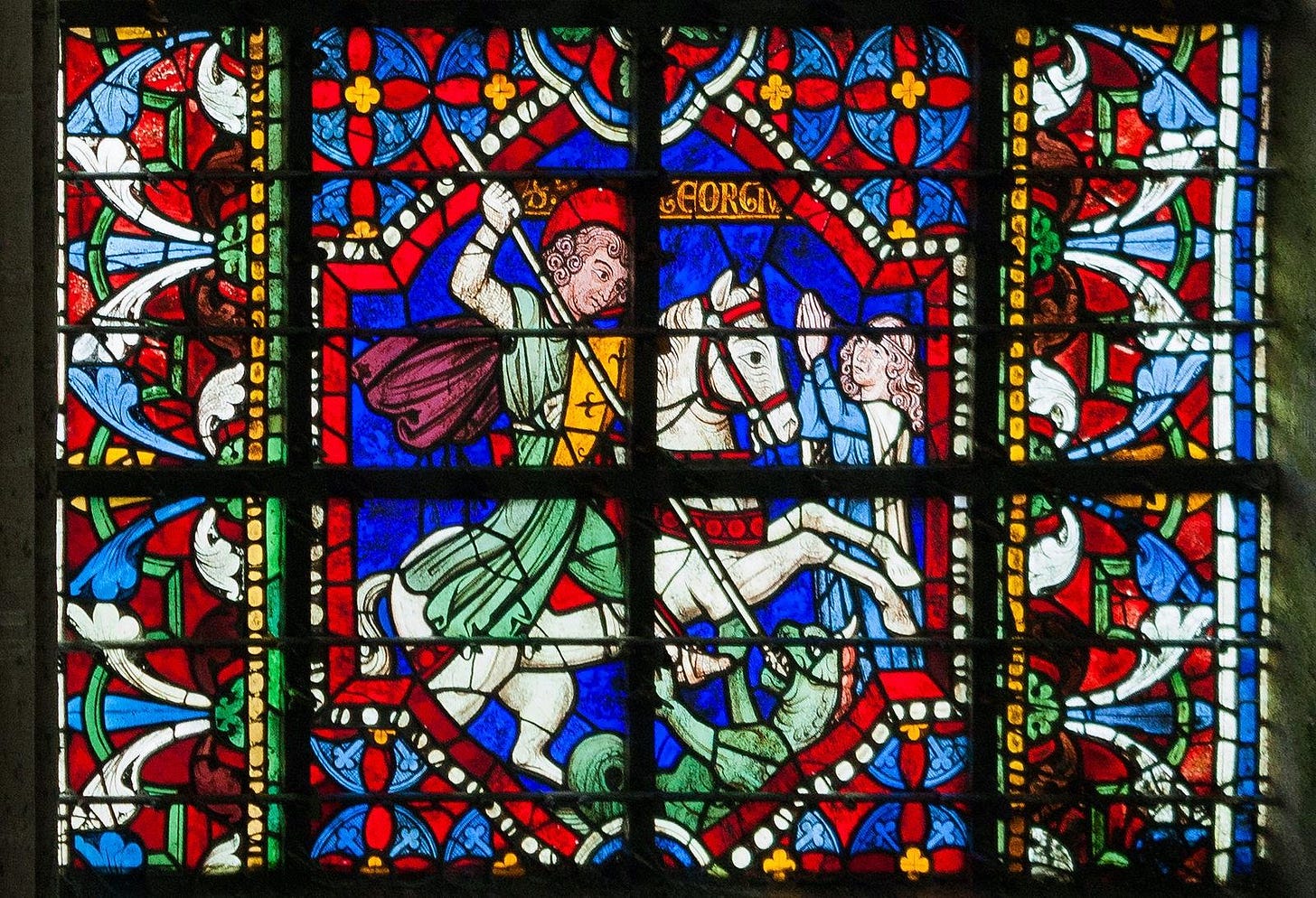We should learn from the story
Of the battle of the two dragons
As found in the book of the Bretons,
In which the castle fell to the ground:
It is the world itself which will be overthrown
If God does not put an end to the battle.
One should call upon the powers of Merlin
To divine what the outcome will be.
The Antichrist draws near, it is clear,
Waving the bludgeons of the Enemy
— Thibaut de Champagne, (ca 1228), translated by Kathleen J. Brahney
Cry 'God for Harry, England, and Saint George!
— Henry V at Agincourt, Shakespeare
The story
The story of St. George exists in many variations, but here is the core of it. I’ll state all of it as fact, keeping in mind we are talking legends here.
George was born in Cappadocia (in modern day Turkey) to Christian Greek parents. His mother was from Lydda (outside modern day Tel Aviv and not far from Arsuf, where Richard battled Saladin). He became an officer in the Roman army, but was arrested, tortured, and eventually beheaded during the Diocletianic Persecution of 303, which targeted Christian soldiers in the Roman army (an historical event).

George, a military leader under Dacian, "king of the Persians," inaugurates his seven years of torture by boldly coming forward to confess his belief in Christ, as Dacian is preparing to persecute Christians in the area. At Dacian's order, George is stretched out on the rack and ripped to shreds with flesh hooks, harnessed to machines that draw him apart, and then beaten, after which salt is poured into his wounds, which are rubbed with a haircloth. He is then pressed into a box pierced with nails, impaled on sharp stakes, plunged into boiling water, and has his head crushed by a hammer. All to no avail. God comforts George in prison and informs him that he will die three deaths before entering Paradise…The next day he is lacerated on a wheel of swords, cut into ten pieces, and thrown into a well that is sealed with a stone…1
The torture goes on from there, but you get the picture.
He was killed and buried, according to legend, at Lydda, on April 23, 303.2 A church remains there to this day, reportedly with his relics.
Prior to being beheaded, he accomplished a number of works or miracles. He prayed over a man’s grave, and the grave opened and the man was resurrected from the dead. He raised a farmer’s dead ox back to life. Other miracles of similar natures were reported. But the story for which he is perhaps best known is the dragon.
The Dragon
In a foreign land, there lived a dragon. The dragon demanded tribute from the villagers: livestock, trinkets, and eventually, once a year, a human. One year, the tribute chosen was a princess. Dressed as a bride she was sent to the dragon. By chance Saint George arrived at just this time. He conversed with her, and she tried to tell him to escape, but the dragon emerged from his lair. Mounted, George made the Sign of the Cross, and charged with his lance, striking the dragon a serious wound. He called to the princess to give him her girdle. He placed it around the dragon’s neck; it kept George safe and the dragon followed the girl like a pet. They returned to the village with the dragon, where George swore he would kill the dragon if the villagers converted to Christianity. They did, and he did.
(By the way, does the girdle story remind you of Gawain and the Green Knight? It should…)
But where was this village?
Now we see how this story intersects with Richard. Last week, we discussed the negotiations between Richard and Saladin. One of the most intensive periods of negotiation was during Richard’s march toward Jaffa, and in particular, just prior to the massive Battle of Arsuf, to be discussed in a future post.
The village the princess was from was…Arsuf.
(In other versions of the story, the village was Selem, in Libya, but for obvious reasons I prefer the Arsuf version.)
The story of the dragon appears to be a later addition to the tale of St. George. The episode first makes its appearance in the 11th century, although St. George was elevated to sainthood in 494. It may have been a “migrated” version of the legend of Perseus and Andromeda, where Perseus kills a sea monster, traditionally at Arsuf or nearly Jaffa3. Returning to St. George, Josephus even recounts having seen at Jaffa the chains which bound the princess to the rock, while St. Jerome says that the bones of the huge reptile were exhibited here in his day.4
In medieval romances, the lance with which Saint George slew the dragon was called Ascalon, named after the town of Ascalon, a port stronghold that was much on the mind of Richard as he marched south from Acre.
Sainthood
In 494, Pope Gelasius I canonized George as a saint among those “whose names are justly reverenced among men, but whose acts are known only to [God].” George was known in England as early as the 4th or 5th century; but not taken as the patron saint of England until 1348.
He was patron saint of Bosnia and Herzegovina until 1752, taken as patron saint of Moscow in 1730, is the patron saint of Ethiopia, and many other towns, islands, and regions.he
How did he come to be England’s saint?
With the Normans the cult of St. George became firmly rooted in England where, in 1348, King Edward III established the Order of the Knights of St. George.5 He was mentioned as a martyr by The Venerable Bede, a monk/scholar, in the 8th century.
The national flag of the United Kingdom, the Union Jack, features the Cross of Saint George.
Sources
Like many myths, the origin story of St. George is shrouded in mystery, as can be seen from Pope Gelasius’ comment above. The most complete version, based upon the fifth-century Greek text but in a later form, survives in a translation into Syriac from about 600. From text fragments preserved in the British Library, a translation into English was published in 1925.6
In the 1260s, Jacobus de Voragine’s Legenda Aurea (Golden Legend) was widely read and is one of the earliest well-known sources. It became widely popular in England when it was translated into English in the 15th century by William Caxton, the first printer in England.
Variations of George’s legend were told in Muslim histories as well.
“The account of one of his deaths by Ibn al-Athir (who we encountered last week reporting Richard’s musical experience with al-Adil) is similar to the crucifixion of Jesus, stating that ‘when he died, God sent stormy winds and thunder and lightning and dark clouds, so that darkness fell between heaven and earth, and people were in great wonderment.’ The darkness was lifted after his resurrection.”7
George would of course make many later appearances in literature and art, including medieval romances, Edmund Spenser’s The Faerie Queen (1597), and up to today in novels and children’s books. Which is appropriate as he is also the patron saint of reading and books!
He also inspired many great works of art from many masters, including Dürer, Rubens, Dali, Raphael, Moreau, stained glass in Notre Dame, and many more. Here’s a sample:









Saint George in the Crusades
Saint George was well known during the Crusades. The appearance of Saint George was believed to have given the Franks hope during the Battle of Antioch in 1098 and a similar event occurred the following year at Jerusalem.
At the Battle of Arsuf, Garnier de Nablus, Grand Master of the Hospitallers, was held back from attacking by Richard. While being attacked by Saladin’s forces, he cried “Saint George, will you let us be defeated like this?” shortly before some of his men launched an un-authorized counterattack, which led to victory.
Legendarily, Richard adopted the Cross of St. George as his standard and put his army under the patronage of St. George, but it’s difficult to find contemporary accounts that demonstrate this.
https://d.lib.rochester.edu/teams/text/whatley-saints-lives-in-middle-english-martyrdom-of-st-george-introduction
https://blogs.goarch.org/blog/-/blogs/saint-george-and-the-dragon
https://en.wikipedia.org/wiki/Saint_George_and_the_Dragon
http://www.studiesincomparativereligion.com/public/articles/The_Dragon_that_Swallowed_St_George-by_Whitall_N_Perry.aspx
https://www.vaticannews.va/en/saints/04/23/st--george--martyr.html
https://en.wikipedia.org/wiki/Saint_George
https://historymedieval.com/st-george-and-the-slaying-of-the-dragon/










